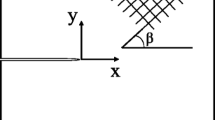Abstract
The traditional compliance-based criterion of the crack stability in fracture mechanics states that the stability of the crack propagation in the different specimens under different fracture modes is determined by the derivative of the energy release rate with respect to the crack length. In this work the compliance-based criterion is verified by experiments performed on fracture mechanical systems. The large number of experiments carried out on different (mode-I, mode-II, mixed-mode I/II and mixed-mode II/III) specimens shows that the stability of the crack propagation depends on the derivative of the critical displacement (the displacement at the point of fracture initiation) with respect to the crack length. The experimentally established limits of crack stability were compared to the limits of the traditional criterion and it is shown that in each case they lead to approximately the same restriction considering the stable zone of crack propagation.









Similar content being viewed by others
References
Hashemi S (1990) J, Kinloch and JG. Williams. The effects of geometry, rate and temperature on mode I, mode II and mixed-mode I/II interlaminar fracture toughness of carbon fibre/poly(ether-ether ketone) composites. J Compos Mater 24:918–956. doi:10.1177/002199839002400902
Hashemi S (1990) J, Kinloch and JG. Williams. Mechanics and mechanisms of delamination in a poly(ether sulphone)-fibre composite. Compos Sci Technol 37:429–462. doi:10.1016/0266-3538(90)90013-U
Schön J, Nyman T, Blom A, Ansell H (2000) Numerical and experimental investigation of a composite ENF-specimen. Eng Fract Mech 65:405–433. doi:10.1016/S0013-7944(99)00137-X
Schuecker C, Davidson BD (2000) Evaluation of the accuracy of the four-point bend end-notched flexure test for mode II delamination toughness determination. Compos Sci Technol 60:2137–2146. doi:10.1016/S0266-3538(00)00113-5
Crews JH Jr, Reeder JR (1988) A mixed-mode bending apparatus for delamination testing. NASA Technical Memorandum 100662, August, 1–37.
Reeder JR, Crews JH Jr (1990) Mixed-mode bending method for delamination testing. AIAA J 28:1270–1276. doi:10.2514/3.25204
Olsson R (1992) A simplified improved beam analysis of the DCB specimen. Compos Sci Technol 43:329–338. doi:10.1016/0266-3538(92)90056-9
Carlsson LA, Gillespie JW, Pipes RB (1986) On the analysis and design of the end notched flexure (ENF) specimen for mode II testing. J Compos Mater 20:594–604. doi:10.1177/002199838602000606
Kim BW, Mayer AH (2003) Influence of fiber direction and mixed-mode ratio on delamination fracture toughness of carbon/epoxy laminates. Compos Sci Technol 63:695–713. doi:10.1016/S0266-3538(02)00258-0
Anderson, TL (2005) Fracture Mechanics—Fundamentals and Applications 3rd edn. CRC, Taylor & Francis Group, Boca Raton, London, New York, Singapore.
Kanninen MF, Popelar, CH (1985) Advanced Fracture Mechanics. Oxford University Press, New York
Wang W-X, Takao Y, Nakata, M (2003) Effects of friction on the measurement of the mode II interlaminar fracture toughness of composite laminates. Proceedings of the 14th International Conference on Composite Materials, San Diego, California, USA, July 14–18.
Szekrényes A (2005) Mode-II fracture in E-glass-polyester composite. J Compos Mater 39(19):1747–1768. doi:10.1177/0021998305051120
Blanco N, Gamstedt EK, Costa J, Trias D (2006) Analysis of the mixed-mode end load split delamination test. Compos Struct 76:14–20. doi:10.1016/j.compstruct.2006.06.003
Reyes G, Cantwell WJ (2000) The mechanical properties of fibre-metal laminates based on glass fibre reinforced polypropylene. Compos Sci Technol 60:1085–1094. doi:10.1016/S0266-3538(00)00002-6
Davidson BD, Sundararaman V (1996) A single leg bending test for interfacial fracture toughness determination. Int J Fract 78:193–210. doi:10.1007/BF00034525
Szekrényes A, Uj J (2007) Over-leg bending test for mixed-mode I/II interlaminar fracture in composite laminates. Int J Damage Mech 16(1):5–33. doi:10.1177/1056789507060774
Sharif F, Kortschot MT, Martin RH (1995) Mode III delamination using a split cantilever beam. In: Martin RH (ed) Composite materials: Fatigue and fracture—Fifth Volume ASTM STP 1230. ASTM, Philadelphia, pp 85–99
Szekrényes A (2007) Delamination fracture analysis in the GII-GIII plane using prestressed transparent composite beams. Int J Solids Struct 44:3359–3378. doi:10.1016/j.ijsolstr.2006.09.029
Szekrényes A (2007) Improved analysis of unidirectional composite delamination specimens. Mech Mater 39:953–974. doi:10.1016/j.mechmat.2007.04.002
Becht G, Gillespie JW Jr (1988) Design and analysis of the crack rail shear specimen for mode III interlaminar fracture. Compos Sci Technol 31:143–157. doi:10.1016/0266-3538(88)90088-7
Acknowledgements
This research work was supported by the János Bolyai Research Scholarship of the Hungarian Academy of Sciences and by the Hungarian National Research Fund (OTKA) under Grant No. 34040. The author is grateful to his father (András L. Szekrényes) for the construction of the experimental equipments.
Author information
Authors and Affiliations
Corresponding author
Rights and permissions
About this article
Cite this article
Szekrényes, A. Crack Stability of Fracture Specimens used to Test Unidirectional Fiber Reinforced Material. Exp Mech 50, 473–482 (2010). https://doi.org/10.1007/s11340-009-9251-8
Received:
Accepted:
Published:
Issue Date:
DOI: https://doi.org/10.1007/s11340-009-9251-8




